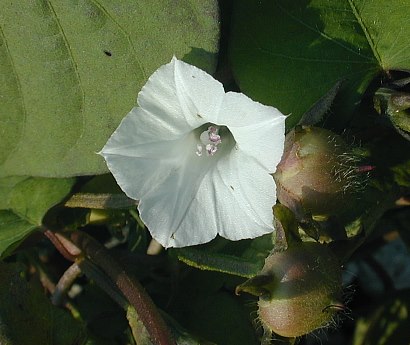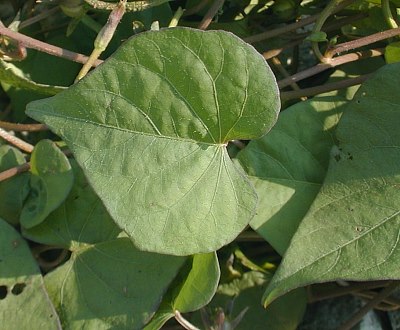Description: This annual plant is a twining vine about 3-7' long. The stems are slightly pubescent, or have scattered white hairs. The larger alternate leaves are usually cordate, although leaves with 3 acute lobes are sometimes observed; smaller leaves are usually ovate. These leaves are 2-4" long and about half as much across. Their margins are smooth, while the upper leaf surface has scattered white hairs. The petioles are long, slender, and more or less pubescent.

From the base of these petioles, develops 1-3 white funnelform flowers from a short stalk. These flowers are up to 1" long and ¾" across. They are shallowly lobed. At the throat of each flower, is a single white stigma with a knobby head, which is closely surrounded by several white stamens with purple or white anthers. Rarely, a flower will have two knobby stigmata. There are 5 light green sepals that are lanceolate, pubsecent or hairy, and about 1/3" long. The blooming period occurs from mid-summer through the fall, and lasts about 2-3 months. Flowers bloom primarily during the morning; there is no noticeable floral scent. They are replaced by 2-valved seed capsules that are spherical and often hairy; these capsules are surrounded by 5 acute bracts. The large seeds are dark brown or black, with an irregular oblong shape and shiny surface. They rely primarily on the vining habit of the plant for their dispersal. The root system consists of a taproot.

Cultivation:
The
preference is full sun and moist to mesic conditions; this plant also
tolerates drier locations. The soil can contain significant amounts of
loam, clay, or gravelly material. The stems will climb fences and
taller plants if given a chance; in open areas, they sprawl about
haphazardly.
Range & Habitat:
The native Small White Morning Glory occurs primarily in southern and
western
Illinois, where it is occasional. In the NE and extreme northern
Illinois, this plant is apparently absent (see Distribution
Map). Habitats include moist to mesic black soil prairies,
thickets, gravelly bars of streams and banks of lakes, moist meadows
near rivers or woodlands, abandoned fields, areas along roadsides and
railroads, and miscellaneous waste areas. This plant favors disturbed
habitats.

Faunal
Associations:
Primarily long-tongued bees visit the flowers for nectar, including
bumblebees and Little Carpenter bees, and such oligoleges as Melitoma
taurea (Mallow Bee), Peponapis pruinosa pruinosa
(Squash & Gourd Bee), and Cemolobus ipomoea
(Morning Glory Bee). Some insects feed on the foliage of this plant,
including the caterpillars of Emmelina monodictyla
(Common Plume Moth) and several species of Tortoise Beetles. The seeds,
as large as they are, are consumed by only a few upland gamebirds to a
limited extent; this includes the Bobwhite and Ring-Necked Pheasant.
Mammalian herbivores don't feed on this plant because the foliage is
somewhat toxic and has a slightly rank smell.
Photographic Location:
Photographs were taken along a railroad in Savoy, Illinois.

Comments: The flowers of this plant are smaller in size than other Morning Glories and Bindweeds. While the flowers of Convolvulus arvensis (Field Bindweed) have about the same length, they are broader when fully open (1" or more). There is some variability across local populations of Small White Morning Glory, particularly with regard to the hairiness of the plant. On rare occasions, the flowers may be pink or light purple. This plant will continue to bloom sporadically until late in the fall, when it is killed by frost.